Have you ever wondered about leveraging the power of email to grow your business and connect with your audience? Then, you should definitely learn more about email marketing and employ different techniques to connect with your customers through emails.
From building a targeted email list to crafting compelling subject lines and content, this guide covers all the essential elements of a successful email marketing campaign. Get ready to boost your brand awareness, drive more traffic and sales, and build strong relationships with your subscribers.
Let’s dive in!
What is email marketing?
We start with the definition of Email marketing, then explain its benefits and in the end, we will learn how to make it.
Email marketing is a direct eCommerce marketing technique that utilizes email as a means of building a relationship with customers and driving sales and revenue through targeted and personalized communications.
It involves sending out emails to a list of subscribers, customers, or prospects, with the purpose of promoting a product, service, or event, as well as nurturing and maintaining the relationship with the audience.
Email marketing can be highly effective when done correctly, as it allows businesses to reach their customers directly in their inboxes, making it easy for them to engage with the content and take action. According to a study published in 2021, the average return on investment (ROI) for email marketing is $38 for every $1 spent, showing how profitable it can be for your business.
Email marketing benefits
Why should you start an email marketing campaign? Does it have any benefits? Here are some of the key benefits this type of marketing has for your business or organization:
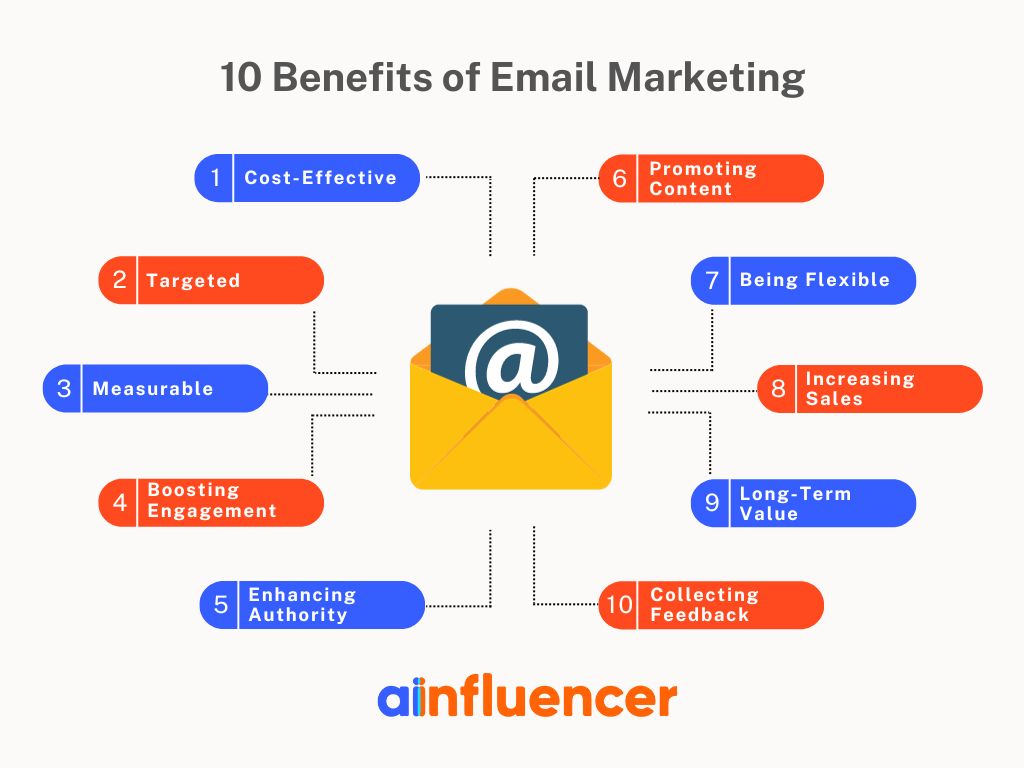
1-Cost-Effective Marketing Technique
Email marketing is one of the most cost-effective eCommerce advertising methods available. You may only need to pay the costs of having an email marketing tool, which is somehow less expensive than most traditional advertising, such as renting a billboard print ads or television commercials.
In fact, email marketing allows businesses to reach a large audience at a relatively low cost. You can easily update your email list whenever a new customer creates an account on your site.
2- Creating Targeted Content
Marketing by email also enables businesses to send targeted messages to specific audience groups. This can be done through personalization and segmentation, allowing businesses to reach their target audience with relevant messages.
3- Being Measurable
This kind of Email marketing provides valuable insights into the effectiveness of campaigns through metrics such as open rates and conversions. These metrics allow businesses to continually improve the content and targeting of their email campaigns.
4- Boosting Engagement
Personalized and targeted emails have been shown to increase engagement and drive conversions. A study by Epsilon found that personalized emails deliver six times higher transaction rates compared to non-personalized emails.
5- Enhancing Authority
By regularly sending well-crafted, informative emails to your subscribers, you can demonstrate your expertise and establish yourself as a trusted source of information. This can help build a loyal following of subscribers who trust and value your opinion, leading to increased brand recognition and customer loyalty.
6- Promoting Content
By sending emails that include links to your latest blog posts, videos, or other types of content, you can drive traffic to your website and increase the visibility of your content.
7- Being Flexible
Email advertising provides businesses with the flexibility to reach their audience at any time and from any location, making it an ideal marketing tool for businesses that need to reach their audience quickly and efficiently.
8- Increasing Sales
Sometimes, people forget the name of your website. Email marketing is a great way to remind your customers about the products or services you offer. Furthermore, introducing new products and special offers can boost sales.
9- Long-Term Value
Unlike other marketing methods that may have a short-term impact, email marketing can have a lasting impact on a business’s bottom line. By building a solid email list and regularly sending targeted messages, businesses can maintain a strong and engaged audience over time.
10. Collecting Feedback
You can collect valuable data from Emails by asking your subscribers to give you their feedback. One effective email marketing method is to create polls and surveys. This allows you to learn about your subscribers’ preferences and identify any obstacles preventing them from completing purchases.
Overall, email marketing offers a range of benefits for businesses and organizations looking to reach their target audience and drive results. From its cost-effectiveness to its flexibility and scalability, email advertising is an effective and valuable tool for businesses of all sizes.
Different types of email marketing
There are several different types of email marketing that businesses and organizations can use to reach their target audience and achieve their marketing goals. Some of the most common types include:
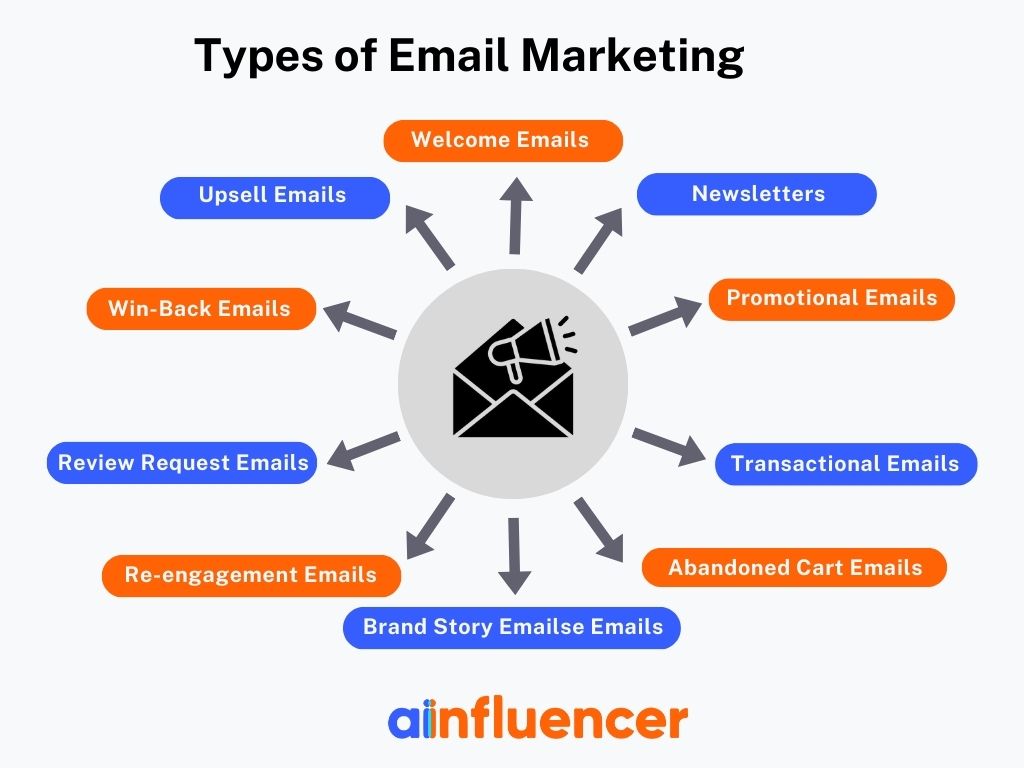
1-Welcome Emails
Our email marketing guide starts with welcome emails; the first email that you send to your subscribers to greet them. You should note that this is one of the most important types of emails because it is the first impression you make with your visitors.
Why Should You Use Welcome Emails?
You may wonder why you should care about welcome emails. are they effective at all?
Here are some benefits that a mindful welcome email has:
- Welcome emails are opened four times more than other types of emails. Almost %50 of welcome emails are read, which gives you enough reason to take your time and add the correct information to it.
- A survey shows that %33 of subscribers expect to receive a welcome email immediately.
- You can create a strong relationship with welcome emails. However, this relationship depends on what you add to your welcome email.
- In general, welcome emails have a better engagement rate than other types of emails.
What Should Be in a Welcome Email?
Generally, the welcome email should have brief information about the company’s mission and history. It shouldn’t be too long because people don’t want to read a full story! They only spend a few minutes on an email. Therefore, create a short, concise, and simple introduction.
Let them know what they can get from this subscription. In addition, inform them that they can unsubscribe anytime they want. However, you must give them compelling reasons to continue their subscription.
Here are some tips to create an effective welcome email:
- The subject line should be warm and friendly.
- To make subscribers feel more valued, it’s important to address them by their name.
- You can give your subscribers a gift, such as a discount code. This way you give them value and a reason to return to your site.
- People are more eager to follow brands on social media. Therefore, ask them to follow your social media accounts to stay connected.
- Although a welcome email is where you introduce your brand, it will be helpful if you let the subscribers talk, too. Ask them their opinion; you can do this by adding a poll to the welcome email.
- Don’t forget to add your branding to the welcome email design.
2-Newsletters
The second most common email type is the newsletter, a regularly scheduled email that provides subscribers with updates on company news, promotions, and other information. In fact, newsletters are one of the best types of email marketing for small businesses.
What Should be in Newsletter Emails?
You may wonder what you should put in your newsletter emails. Here are some ideas:
- Articles and blog posts.
- News about your company.
- Business changes that may impact the subscribers.
- New products or services.
- Special events.
- Discounts.
- Reviews or best practices.
- A top ten list of the month.
- Polls or surveys.
- Statistics about your business.
3- Promotional Emails
Emails that are specifically designed to promote a product or service and encourage subscribers to make a purchase. Although this might be very similar to newsletters, promotional emails are designed only for promoting products. Therefore, there might not be other information on it. So, how can we create this type of email marketing campaign? Let’s see what should be on it.
What Should Be in Promotional Emails?
- Special offers during holidays. As an example, you can send a dedicated promotional email for Black Friday or other events. (See other Black Friday marketing strategies)
- Product launches. You can inform your subscribers when your next product will be launched or released.
- You can send your subscribers exclusive offers from time to time to not only return them to your website but also give them a reason to stay connected.
- Inform your subscribers of current sales, restocked items, and limited offers.
- Birthday or anniversary emails are also considered promotional. Give your subscribers a gift on their birthday.
4- Transactional Emails
This type of email marketing is an automatically triggered email that is sent in response to a specific action taken by the recipient. Examples include order confirmations, shipping notifications, and password reset emails.
Transactional emails are usually informational. Therefore, they don’t need to have an unsubscribe link. Additionally, the recipient can’t reply, either, because this email is sent only to give them specific information about the previous action they had taken.
The following emails are considered transactional:
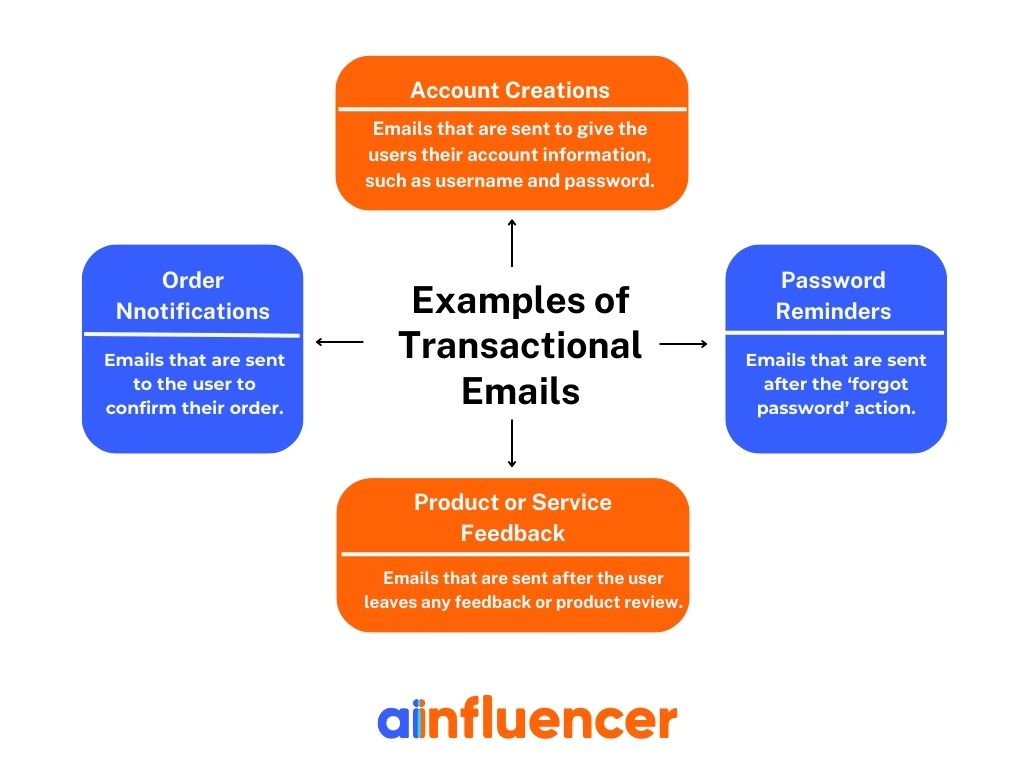
- Account creations (Emails that are sent to give the users their account information, such as username and password).
- Password reminders (Emails that are sent after the ‘forgot password’ action).
- Order notifications (Emails that are sent to the user to confirm their order).
- Product or service feedback (Emails that are sent after the user leaves any feedback or product review).
You should note that transactional emails are usually personalized. This type of email is not a bulk email because it is sent to a specific user for a certain reason.
5- Abandoned Cart Emails
One of the most important types of emails is the abandoned cart emails to remind the user that they have an unfinished order. These emails are sent to customers who have added items to their shopping cart but have not completed the purchase. These emails are designed to encourage customers to complete the purchase.
Did you know more than 40% of abandoned cart emails are read by customers? Guess how much revenue you will have if even %50 of them return to their shopping cart to finish their purchase.
6- Re-Engagement Emails
This type of email is usually sent to subscribers who have not opened or engaged with your emails in a while. As the name indicates, the main goal behind this email is to convert inactive users to customers. Therefore, you should have compelling offers for these users to come back to your website.
Re-engagement emails have many benefits, such as:
- Increasing conversion rate.
- Reminding users of your brand and product.
- Improving customer relationships.
What Should Be in Re-Engaging Emails?
The content of the re-engaging emails is critical because it can turn them into active users or make them unsubscribe from your list. Therefore, give them appealing reasons to come back. Here are some tips that can help you create a better re-engagement email:
- A discount code can be compelling enough for an inactive user to click and visit your website.
- Start a friendly conversation by asking them a short question. But the answer to this question should be the reason they re-engage with your brand.
- “We Miss You” messages can work well most of the time.
- Use the previous data you have about the customer to show you know them and still care about their needs or fears.
- You can also create a sense of urgency. For example, address their name and notify them they have an unused discount code that will expire in a week.
- Ask their feedback.
- Make this email as much fun as possible.
7- Upsell Emails
The most essential part of email marketing is to keep existing customers and re-engage the inactive ones. Therefore, you should always have different plans and create different types of emails. In this case, upsell emails are sent to existing customers to promote complementary or higher-end products or services.
What Should be in Upsell Emails?
- Product recommendations.
- Short call to action (CTA) button with interesting text.
- Discount or special offer on specific products.
8- Win-Back Emails
Win-back emails are those emails sent to former customers to try to win them back and encourage them to make a purchase. The difference between win-back and re-engagement emails is that win-back targets previous customers, while re-engagement targets non-responders or the ones who haven’t purchased any product yet.
9- Review Request Emails
Another type of email marketing that can engage customers is the review request emails. After a customer receives a product or service, a company can send review request emails to ask for feedback. By sending this type of email, you demonstrate to the customers that you care about their satisfaction. That’s why it is one of the most influential emails in customer relationship strategy.
10- Brand Story Emails
This type of email is designed to increase brand awareness through email marketing. Brand story emails create an emotional connection between your brand and customers. You can run brand story email campaigns occasionally to re-introduce yourself to your subscribers and customers.
You should note that this type of email differs from welcome emails because the focus of brand story emails is on the brand so it can include the brand’s mission, goals, achievements, changes, etc. All in a storytelling form.
These are just a few examples of the different types of email marketing. It is important to note that you usually don’t use only one type of email, sometimes you may need to incorporate all types of mentioned emails in your marketing strategy. Therefore, don’t only stick to one.
How to start email marketing?
Now that you know the benefits and different types of email marketing, let’s check how to start this marketing strategy and promote your brand.
The following guide to email marketing can help you take your steps towards this type of marketing and promote your brand and products more effectively.
1. Create an email marketing strategy
Before you start sending emails, it’s crucial to have a clear plan in place. Determine your target audience, what you want to achieve with your email campaigns, and what type of content you want to send. This will help you to focus your efforts and measure your success.
Depending on your specific business goals and target audience, you can choose the type of email that suits your email marketing strategy.
2. Set SMART goals
Once you have a strategy in place, set specific, measurable, achievable, relevant, and time-bound (SMART) goals for your email marketing campaigns. For example, your goal might be to increase your email open rates by 10% over the next six months.
3. Build your email list
Building an email list is a critical part of any successful email marketing strategy. An email list allows you to connect directly with your target audience and promote your products or services directly to them. Here’s an overview of each step you can take to build your email list:
How to Build an Email List?
By following these tips, you can build a high-quality email list:
- Use Lead Magnets: Offer something valuable to your website visitors in exchange for their email addresses, such as a free ebook, a discount code, or a webinar.
- Create an Attractive Opt-In Form: Make sure your opt-in form is well-designed, prominently displayed on your website, and easy to use.
- Implement Enticing Pop-Ups: Offer something valuable in pop-ups to collect email addresses from your website visitors.
- Use Social Media: You can use Facebook, Twitter, Instagram, and other platforms to drive traffic to your website and encourage visitors to sign up for your email list.
- Use Check-Outs: If you have an eCommerce website, you can use your checkout process to collect email addresses from your customers.
- Do It Offline: If you have a physical store or attend trade shows, you can also collect email addresses offline. You can use a sign-up sheet or have a dedicated tablet or computer for visitors to enter their email addresses.
Important Note: Never buy an email list. The email addresses on purchased lists are often outdated or fake, and sending emails to these addresses can harm your reputation and result in your email being marked as spam.
4. Plan and run your first email marketing campaign
Now that you have a strategy and a targeted email list, you can start planning your first email marketing campaign. Decide on the type of email you want to send (e.g., promotional, informative, or transactional), create a compelling subject line, and write engaging content that speaks to your subscribers. Then you can set the perfect time and send your email.
Do not forget to test your email campaign before sending it to your entire list to ensure everything is working correctly.
5. Track the results
After you’ve sent your email campaign, track the results to see how well it performed. Use metrics like open rates, click-through rates, and conversion rates to measure the success of your campaign and make improvements for future campaigns.
Using email marketing tools and services can help you create a detailed report about your campaign performance.
to a company’s reputation, so it’s necessary to take them seriously.
Email regulations
There are several key regulations that companies must abide by when sending marketing emails. Here are some of the most important ones:
CAN-SPAM Act (United States)
This law governs the sending of commercial emails and sets standards for what information must be included in such messages, as well as giving recipients the right to opt out of receiving further emails.
Under the CAN-SPAM Act, companies must include their physical mailing address in the email, provide a clear and conspicuous opt-out mechanism, and honor opt-out requests within 10 business days.
General Data Protection Regulation (GDPR) (European Union)
The GDPR sets standards for how companies can collect, use, and process personal data, including email addresses. Companies must obtain clear and informed consent from individuals before sending marketing emails and must provide an easy way for individuals to opt out of receiving further emails. They must also delete personal data upon request.
Anti-Spam Legislation (CASL) (Canada)
This legislation sets standards for sending commercial electronic messages, including marketing emails. Companies must obtain consent from individuals before sending marketing emails and must include an unsubscribe mechanism in the email.
Privacy and Electronic Communications Regulations (PECR) (United Kingdom)
This regulation governs the sending of electronic marketing messages, including emails, and requires companies to have a valid reason for sending such messages, such as the recipient’s prior consent.
The regulations also require companies to include an opt-out mechanism in the email.
In addition to the above-mentioned regulations, there are also similar laws in other countries, such as the Australian Spam Act. It’s vital for companies to be aware of the specific regulations that apply in the countries where they do business and to ensure that their marketing emails comply with those regulations.
What are the best email marketing tools?
There are several popular email marketing tools that you can choose from, depending on your specific needs, budget, and requirements. Check out the following list:
Here are some of the best email marketing tools:
1-Mailchimp
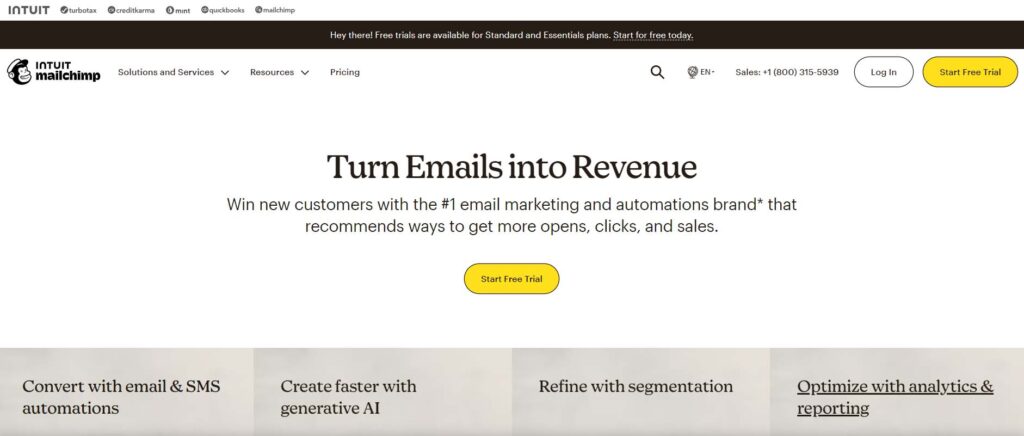
This widely popular email marketing tool offers a free plan for businesses with a small email list. It has a user-friendly interface and features like automation, landing pages, and integration with various eCommerce platforms.
2- Constant Contact
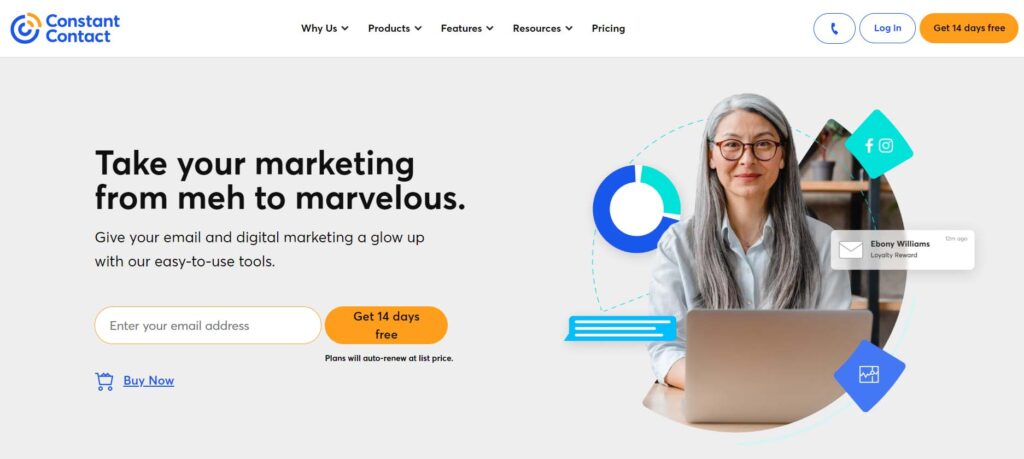
If you want to design your own email templates, automate the sending process, and have a deep analysis of how an email marketing campaign has performed, Constant Contact can be helpful, especially for small businesses.
3- Aweber
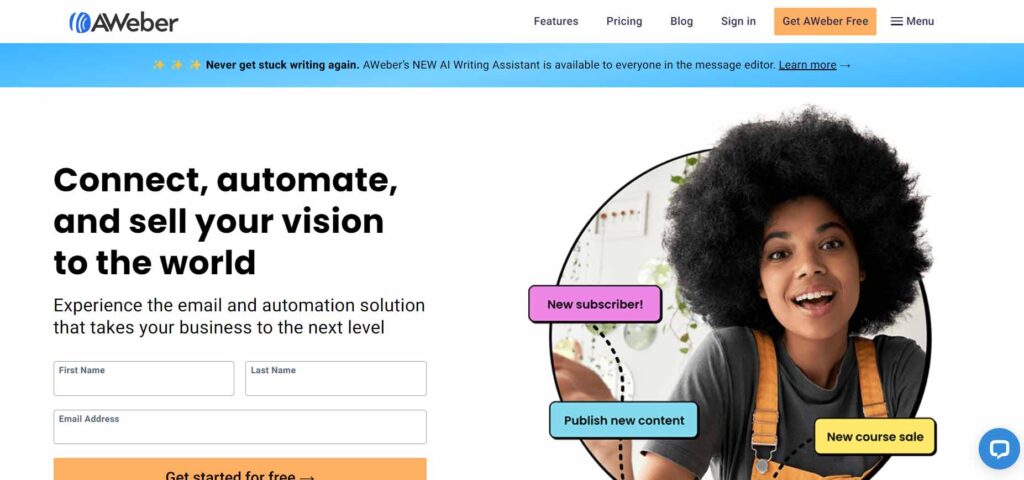
Aweber is a well-established email marketing tool that provides a range of features, such as automation, landing pages, and email design templates. It is a good choice for businesses of all sizes.
4- Campaign Monitor
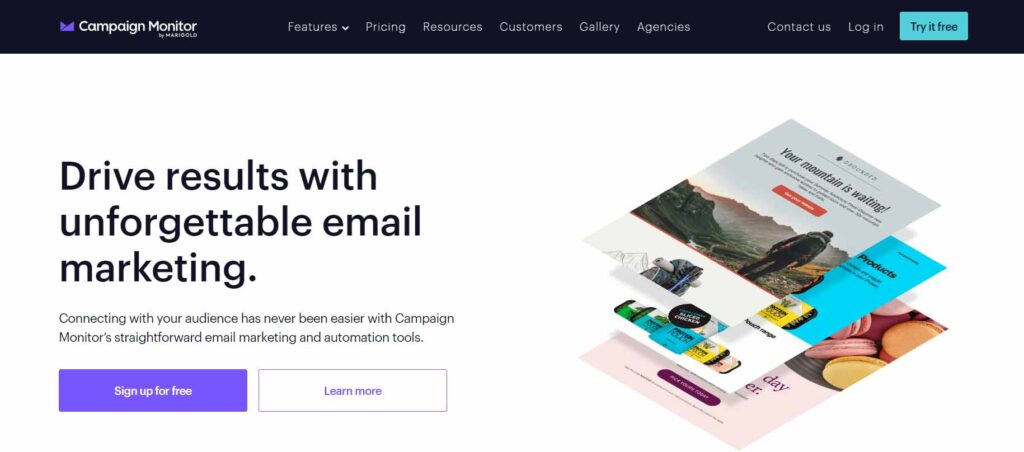
Campaign Monitor is an email marketing tool that focuses on delivering high-quality, professional email campaigns. It offers a range of features, including automation, A/B testing, and a user-friendly email designer.
5- GetResponse
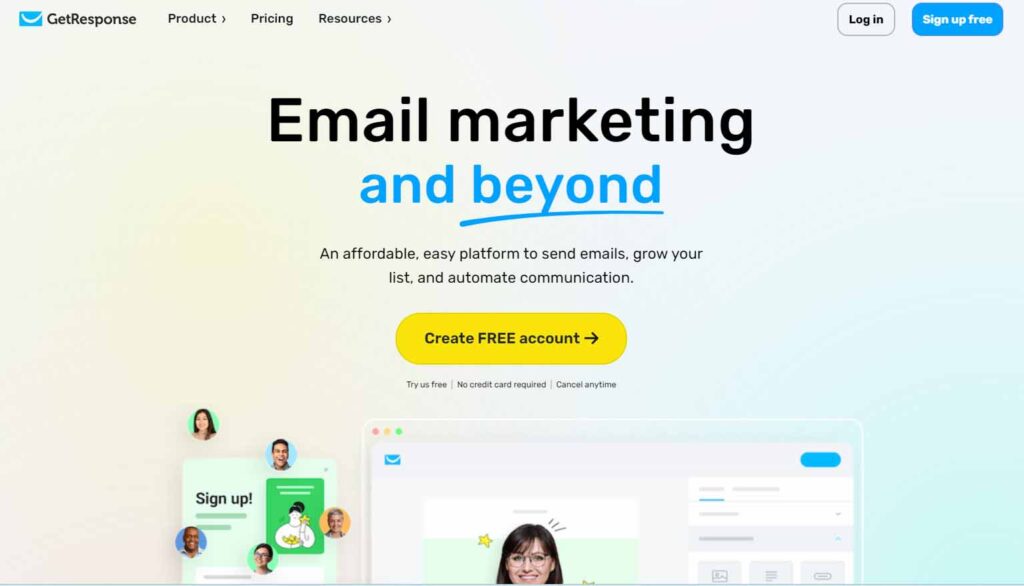
GetResponse is an all-in-one marketing platform that offers email marketing, landing pages, webinars, and more. It is particularly suitable for small businesses and individuals looking for an all-in-one solution.
3 best email marketing examples
Let’s go through three great email marketing examples to help you get inspired:
Airbnb

Airbnb uses email marketing to encourage users to book a trip by recommending places based on their search history and preferences. They often include a personalized subject line and beautiful images of the destinations. Airbnb’s goal with these types of emails is to encourage users to continue using their platform to plan their trips and book accommodations.
Spotify

Spotify sends personalized email notifications to their users with upcoming concerts and events from their favorite artists based on their listening habits, location, and other preferences. These emails usually include details such as the artist, venue, date, and ticket purchase links. The goal of this email marketing is to keep users engaged and informed about their favorite artists and encourage them to attend live events.
Grammarly
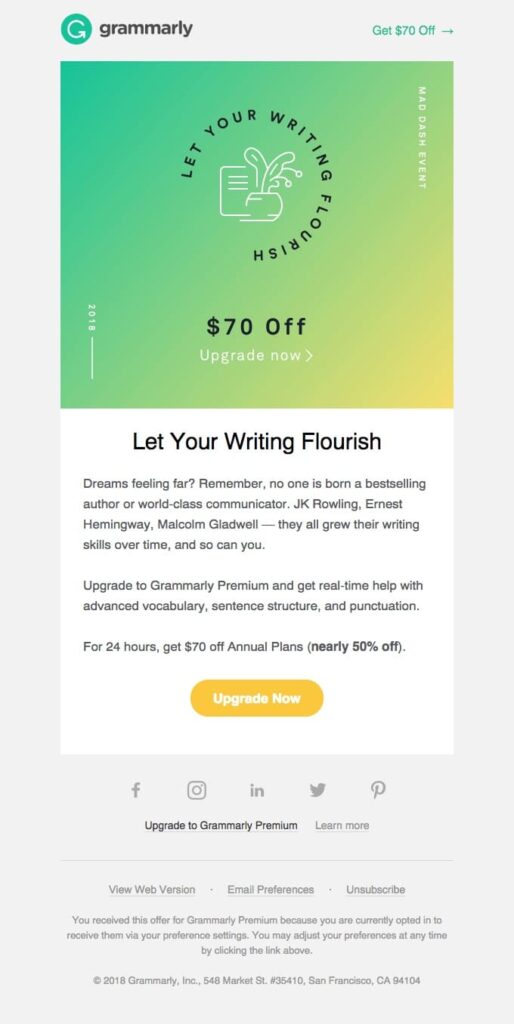
Grammarly is an app that helps people improve their writing skills, and their email marketing campaigns reflect this mission. Grammarly uses email to promote its premium package and encourage users to upgrade. They typically highlight the benefits of the premium features and emphasize how they can help users improve their writing. They may also offer promotions or discounts to incentivize users to upgrade.
These three examples mentioned above showcase effective email marketing strategies that aim to provide value to their users while promoting their products and services in a creative and engaging way.
Conclusion
In conclusion, email marketing is a powerful tool that can help businesses and individuals connect with their audience and achieve their marketing goals. By crafting effective email campaigns that resonate with your audience, you can build trust, engagement, and brand loyalty, ultimately leading to increased conversions and revenue.
Remember, marketing by email is not a one-size-fits-all solution, and it takes time and effort to develop a successful strategy. However, by consistently providing value to your subscribers, testing and optimizing your campaigns, and staying up-to-date with the latest trends and best practices, you can achieve your email marketing goals and take your business to the next level.
FAQs
The 80/20 rule, also known as the Pareto principle, is a concept that can be applied to many areas of business, including email marketing. In this context, it suggests that 80% of your results (such as opens, clicks, and conversions) will come from 20% of your efforts (such as your highest-performing emails or subscribers).
In email marketing, this means that you should focus on delivering high-quality content to your subscribers, targeting the 20% of your audience who are most engaged and likely to take action. This may involve segmenting your audience based on their behavior or interests and tailoring your content to their specific needs.
At the same time, it’s important to avoid overwhelming your subscribers with too many emails, as this can lead to unsubscribes and reduced engagement. Instead, focus on providing value and building a relationship with your subscribers, using the 80/20 rule as a guideline for optimizing your email marketing strategy.
The 5 Ts of email marketing are a framework that can help guide your strategy and improve the effectiveness of your campaigns. They are:
1. Targeting: Segmenting your audience based on their behavior or characteristics, such as demographics or interests, to ensure that your content is relevant and valuable to each subscriber.
2. Timing: Sending your emails at the most appropriate time to maximize open rates and engagement, which may vary based on factors such as time zones, industry, and your specific audience.
3. Testing: Experimenting with different elements of your emails, such as subject lines, calls-to-action, and content, to optimize your campaigns and improve performance over time.
4. Tracking: Measuring the success of your campaigns through metrics such as open rates, click-through rates, and conversions and using these insights to refine your strategy and improve results.
5. Triggering: Sending targeted and timely emails based on specific actions or events, such as a subscriber joining your list, making a purchase, or abandoning a cart, to increase engagement and drive conversions.
Transactional emails are emails that are sent to an individual recipient following a commercial transaction or specific action performed by that person. Since abandoned cart emails are triggered by the customer’s behavior on the website, they are considered transactional.
No campaign works without setting a goal and having a strategy. Therefore, you need to follow some best practices and strategies to make it work for your specific goals and audience. One of the best things that can help you in this way is using email marketing services that can help you measure your campaigns and analyze their effectiveness.
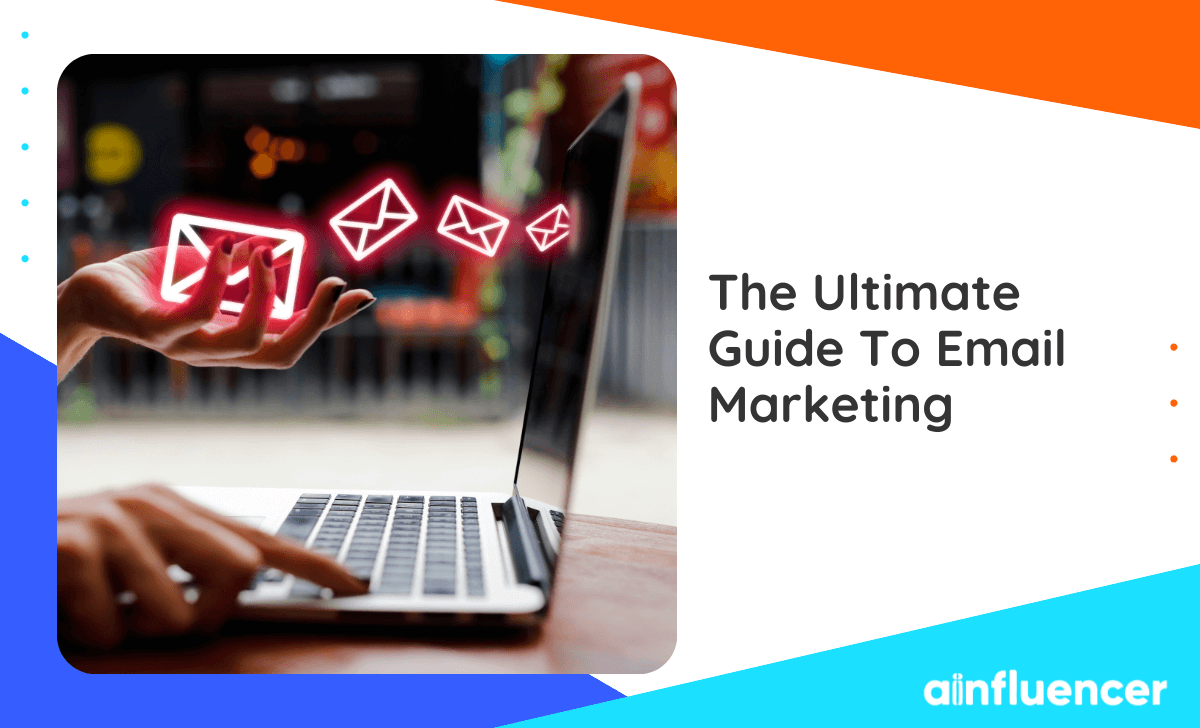
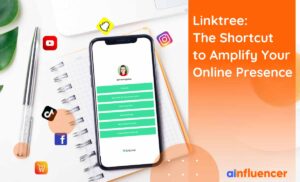


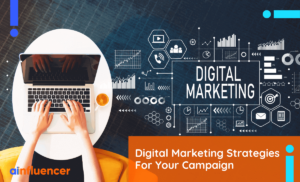
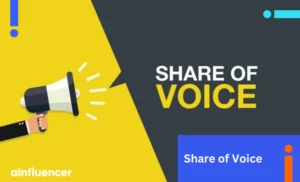
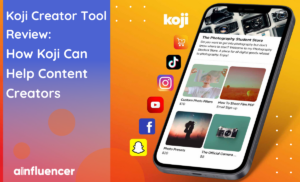

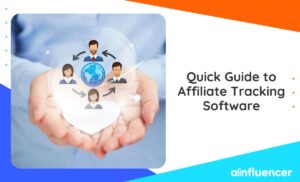
![Read more about the article How to Become a Fashion Nova Ambassador: [The Ultimate Guide + Best Alternative in 2024]](https://blog.ainfluencer.com/wp-content/uploads/2023/12/Fashion-Nova-ambassador-featured-1-300x182.jpg)